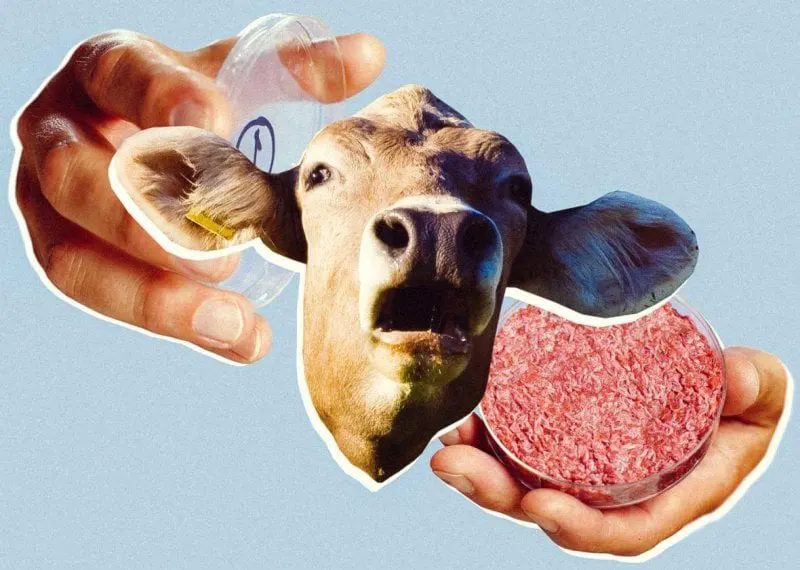Viewpoint: The messy details of how lab-grown meat is made
Viewpoint: The messy details of how lab-grown meat is made


Lab meat—flesh grown in massive tanks instead of in the bodies of sentient animals—offers the promise of having our steak and eating it guilt-free, too.
No vast amounts of water-polluting chemicals to grow feed crops; no low-paid, oft-injured slaughterhouse workers; no climate-warming gases from cow burps or manure lagoons, and no billions of animals slaughtered each year to satisfy our carnivory.
Yet several obstacles hold back a new era of widely available animal-free burgers, nuggets, and carnitas. The biggest involves something much less appetizing than chicken dumplings: the blood of unborn cow fetuses, extracted from their mothers after slaughter, [called fetal bovine serum].
…
The first is expense. FBS sells for upward of $1,000 per liter—a major reason why, to break even on expenses, companies would have to sell their cultured meat for about $200,000 per pound.
…
The other big problem is optics: You can’t market your product as “slaughter-free,” let alone vegan, when you used a slaughterhouse byproduct to grow it… As a result, cultivated-meat companies are scrambling to find FSB substitutes. Such a “serum-free” growth medium exists, reports the Good Food Institute, a think tank that supports conventional-meat replacements. Trouble is, it currently costs nearly $400 per liter—still way too high to be commercially competitive.
This is an excerpt. Read the original post here.

 | Videos | More... |

Video: Nuclear energy will destroy us? Global warming is an existential threat? Chemicals are massacring bees? Donate to the Green Industrial Complex!
 | Bees & Pollinators | More... |

GLP podcast: Science journalism is a mess. Here’s how to fix it

Mosquito massacre: Can we safely tackle malaria with a CRISPR gene drive?

Are we facing an ‘Insect Apocalypse’ caused by ‘intensive, industrial’ farming and agricultural chemicals? The media say yes; Science says ‘no’
 | Infographics | More... |

Infographic: Global regulatory and health research agencies on whether glyphosate causes cancer
 | GMO FAQs | More... |

Why is there controversy over GMO foods but not GMO drugs?

How are GMOs labeled around the world?

How does genetic engineering differ from conventional breeding?
 | GLP Profiles | More... |

Alex Jones: Right-wing conspiracy theorist stokes fear of GMOs, pesticides to sell ‘health supplements’




 Viewpoint — Fact checking MAHA mythmakers: How wellness influencers and RFK, Jr. undermine American science and health
Viewpoint — Fact checking MAHA mythmakers: How wellness influencers and RFK, Jr. undermine American science and health Viewpoint: Video — Big Solar is gobbling up productive agricultural land and hurting farmers yet providing little energy or sustainabilty gains
Viewpoint: Video — Big Solar is gobbling up productive agricultural land and hurting farmers yet providing little energy or sustainabilty gains Trust issues: What happens when therapists use ChatGPT?
Trust issues: What happens when therapists use ChatGPT? Fighting deforestation with CO2: Biotechnology breakthrough creates sustainable palm oil alternative for cosmetics
Fighting deforestation with CO2: Biotechnology breakthrough creates sustainable palm oil alternative for cosmetics California, Washington, Oregon forge immunization alliance to safeguard vaccine access against federal undermining
California, Washington, Oregon forge immunization alliance to safeguard vaccine access against federal undermining 30-year-old tomato line shows genetic resistance to devastating virus
30-year-old tomato line shows genetic resistance to devastating virus The free-range chicken dilemma: Better for birds, but with substantial costs
The free-range chicken dilemma: Better for birds, but with substantial costs ‘You have to treat the brain first’: Rethinking chronic pain with Sanjay Gupta
‘You have to treat the brain first’: Rethinking chronic pain with Sanjay Gupta
